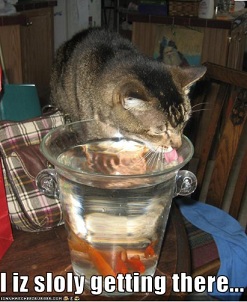 Overall, a cat is around 80 percent water. That’s an even higher percentage than we humans are at around 65 percent (or even the popularly assumed 2/3rds, the average for most lifeforms). Needless to say, a creature who contains that much water is in trouble if they don’t take in enough fluids.
Overall, a cat is around 80 percent water. That’s an even higher percentage than we humans are at around 65 percent (or even the popularly assumed 2/3rds, the average for most lifeforms). Needless to say, a creature who contains that much water is in trouble if they don’t take in enough fluids.
Severe dehydration isn’t common in cats and is usually the result of illness or extreme heat. Many cats, however, suffer from mild dehydration–or rather, insufficient hydration–that doesn’t always show obvious symptoms. Nonetheless, a cat who isn’t taking in enough liquid can suffer from urinary tract problems, which results in litter box problems.
Why House Cats are Prone to Mild Dehydration
Cats have a low thirst drive. They may not feel thirsty until they’ve lost up to eight percent of their body’s water stores. For comparison, humans feel thirsty after we’ve lost around two percent of our water stores.
House cats, naturally, evolved from the big cats of the African plains and other hot, dry places. In those climates, standing or running water is hard to come by, so cats evolved to live without a strong need to drink from lakes, streams, and other water sources.
But they still need fluids. Where do they get it? From their food: raw meat. Biologically, house cats they don’t differ much from the big cats. They’ve inherited this low thirst drive that no longer serves them now that they aren’t living on raw meat. (A little like how we humans inherited the ability to store lots of fat!) An old, but relevant study from 1959 discovered that cats become dehydrated if their food contains less than 61 percent water (1).
Helping Your Cat Get Enough Water
If you feed only wet food, your cat may not need to drink much at all, although she should still have constant access to fresh water. If you feed only dry food (which isn’t a good idea), your cat will need to drink and may need as much as 6 to 8 ounces of pure water a day to stay healthy.
- Provide canned wet food — You may have noticed that pricey canned cat food on the store shelves is as much as 80 percent water. Don’t worry! That’s a good thing. The cat food manufacturers aren’t trying to cheat you by selling you meat-flavored tap water. Instead, they’ve incorporated a necessary amount of water into the food to support your cats health. This type of food is the ideal way for your cat to take in fluids, so if at all possible, make sure she gets enough wet food.
- Provide clean water — Fresh water should be available at all times. If your tap water is heavily chlorinated, get a filter like a Brita filter and give your kitty some better-smelling water. Spring water and other non-mineral-rich bottled water is another option, but avoid giving mineral water. (Excess minerals can also cause urinary tract problems.) Wash the bowl daily to prevent a nasty bacterial slime from forming at the bottom. And keep the food and water bowls away from litter box area.
- Try different bowl types — Some cats like certain types of bowls (glass, ceramic, or stainless steel; shallow or deep; different shapes, etc.). According to experts from the Paws, Whiskers and Claws clinic in Marietta, Georgia, shallow, glass bowls are particularly popular with cats.
- Offer running water — Your cat may also enjoy a fountain-type bowl that provides running water. If your cat likes to drink from the bathroom tap, leave the door open and the tap dripping just slightly so she has access to her favorite water source.
- Set out multiple bowls — Appeal to your cat’s natural love of exploring and foraging by placing multiple small bowls of water around the house.
- Make cat soup — That’s soup for cats, not from cats. 🙂 Although wet food is already, well, wet, you can make a soup-like mixture by placing a few spoonfuls of wet food in a bowl and adding enough water to make it runny. Water in food is a more natural way for cats to get their fluids, so you aren’t ruining her meal this way. You can also add a little water to dry food, if your kitty’s a dry-food addict.
- Offer flavored water — Try adding a few drops of fish or seafood juice (from tuna, salmon, clams, etc.) to your cat’s water. The food-like flavor may encourage her to drink. On the other hand, she may avoid flavored water altogether, so keep another bowl of plain water out to give her a choice.
Keep in mind that the health problems caused by mild dehydration can result in litter box problems. If you’ve been feeding your cat dry food only and she’s been showing inappropriate urination behavior, take her to the vet. The vet can test for a pH imbalance and L-methionine (an amino acid) deficiency, both of which may cause urination problems. Otherwise, though, make it a point to ensure your kitty gets enough fluids either in food or pure water so she won’t be prone to health and urination problems in the future.
1. Prentiss PG. Wolf AV. Eddy HE. “Hypopenia in cat and dog: ability of the cat to meet its water requirements solely from a diet of fish or meat;” American Journal of Physiology; March 1959.


